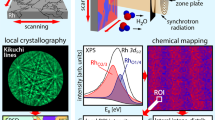Abstract
IT WAS realized as early as 19061 that coupling between an autocatalytic reaction and the diffusion of the autocatalytic component can give rise to a propagating reaction front—a chemical wave. Chemical waves have been studied intensively in fluid-phase reaction–diffusion systems2, but in recent years a variety of spatiotemporal patterns has also been observed for oscillatory reactions on single-crystal surfaces3,4. One important new aspect that has been introduced by these studies is that of anisotropic diffusion, as a consequence of the fixed surface geometry on which the diffusion of the adsorbed particles takes place. Here we report the observation of a transition from elliptical to square-shaped concentric chemical waves in the reaction of NO and H2 on a rhodium(HO) surface. The elliptical pattern is characteristic of simple anisotropic diffusion, but we attribute the origin of the square pattern to a state-dependent anisotropy—that is an anisotropy that varies along the wave profile as changes in the adsorbate coverage generate different reconstructions of the substrate structure. This interplay between diffusional anisotropy and the state of the system can be expected to be quite general and to give rise to new varieties of oscillatory patterning.
This is a preview of subscription content, access via your institution
Access options
Subscribe to this journal
Receive 51 print issues and online access
$199.00 per year
only $3.90 per issue
Buy this article
- Purchase on Springer Link
- Instant access to full article PDF
Prices may be subject to local taxes which are calculated during checkout
Similar content being viewed by others
References
Luther, R. Z. Elektrochem. 12, 596–600 (1906).
Swinney, H. & Krinsky, V. I. (eds) Physica D49 (1991).
Ertl, G. Science 254, 1750–1755 (1991).
Imbihl, R. Prog. Surf. Sci. 44, 185–343 (1993).
Comelli, G. et al. Surf. Sci. 277, 31–42 (1992).
Kiskinova, M., Lizzit, S., Comelli, G., Paolucci, G. & Rosei, R. Appl. Surf. Sci. 64, 185–196 (1993).
van Tol, M. F. H., Gielbert, A. & Nieuwenhuys, B. E. Appl. Surf. Sci. 67, 179–187 (1993); Catal. Lett. 16, 297–309 (1992).
Engel, W., Kordesch, M. E., Rotermund, H. H., Kubala, S. & von Oertzen, A. Ultramicroscopy 36, 148–153 (1991).
Murray, P. W. et al. Phys. Rev. B47, 12976–12979 (1993).
Leibsle, F. M., Murray, P. W., Francis, S. M., Thornton, G. & Bowker, M. Nature 363, 706–709 (1993).
Murray, P. W. et al. Phys. Rev. Lett. 71, 4369–4372 (1993).
Mikhailov, A. S. Phys. Rev. E (in the press).
Author information
Authors and Affiliations
Rights and permissions
About this article
Cite this article
Mertens, F., Imbihl, R. Square chemical waves in the catalytic reaction NO + H2 on a rhodium(110) surface. Nature 370, 124–126 (1994). https://doi.org/10.1038/370124a0
Received:
Accepted:
Issue Date:
DOI: https://doi.org/10.1038/370124a0
This article is cited by
-
The O2 + NH3 Reaction Over Rh(110): Steady State Kinetics and Oscillatory Behavior
Catalysis Letters (2012)
-
Hysteresis and oscillations in the selectivity during the NO-H2 reaction over Rh(533)
Catalysis Letters (1995)
Comments
By submitting a comment you agree to abide by our Terms and Community Guidelines. If you find something abusive or that does not comply with our terms or guidelines please flag it as inappropriate.



